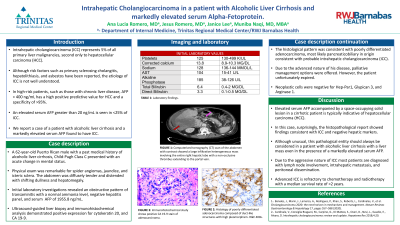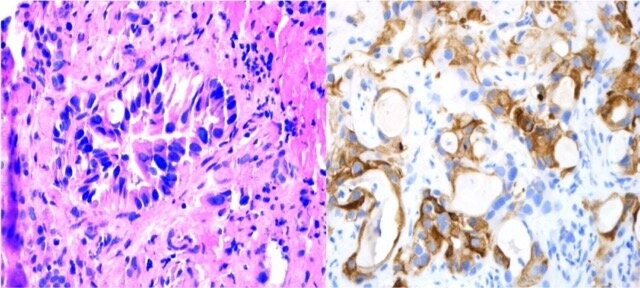Back


Poster Session B - Monday Morning
Category: Biliary/Pancreas
B0025 - Intrahepatic Cholangiocarcinoma in a Patient With Alcoholic Liver Cirrhosis and Markedly Elevated Serum Alpha-Fetoprotein
Monday, October 24, 2022
10:00 AM – 12:00 PM ET
Location: Crown Ballroom

Has Audio

Ana Romero, MD
RWJ Barnabas Health/Trinitas Regional Medical Center
Elizabeth, NJ
Presenting Author(s)
Ana Lucia Romero, MD1, Jesus E. Romero, MD1, Janice Lee, 1, Shruti Jesani, MD1, Islam Younes, MBBCh2, Muniba Naqi, MD, MBA1
1RWJ Barnabas Health/Trinitas Regional Medical Center, Elizabeth, NJ; 2Rutgers Health/Trinitas Regional Medical Center, Elizabeth, NJ
Introduction: Intrahepatic cholangiocarcinoma (ICC) represents 5% of all primary liver malignancies, second only to hepatocellular carcinoma (HCC). Although risk factors such as primary sclerosing cholangitis, hepatolithiasis, and asbestos have been reported, the etiology of ICC is not well understood. An elevated serum AFP accompanied by a space-occupying solid lesion in a cirrhotic patient is typically indicative of HCC. In high-risk patients, such as those with chronic liver disease, AFP > 400 ng/mL has a high positive predictive value for HCC and a specificity of >95%. An elevated serum AFP greater than 20 ng/mL is seen in < 25% of ICC.
Case Description/Methods: We present a patient with a past medical history of alcoholic liver cirrhosis Child-Pugh Class C presenting with acute change in mental status. On arrival, he was hemodynamically stable with classic stigmata of chronic liver disease on the exam. Non-contrast CT Head was non-revealing. Laboratory investigations revealed an obstructive pattern of transaminitis with a normal ammonia level, negative hepatitis panel, and serum AFP of 1955.8 ng/mL. EGD demonstrated portal hypertensive gastropathy. CT Abdomen/Pelvis demonstrated a large infiltrative heterogeneous mass involving the entire right hepatic lobe with a non-occlusive thrombus extending to the portal vein. Ultrasound-guided liver biopsy and immunohistochemical analysis demonstrated positive expression for cytokeratin 20, and CA 19-9. Neoplastic cells were negative for Hep-Par1, Glypican 3, and Arginase 1. The histological pattern was consistent with poorly differentiated adenocarcinoma, most likely pancreaticobiliary in origin consistent with intrahepatic cholangiocarcinoma (ICC).
Discussion: Elevated serum AFP accompanied by a space-occupying solid lesion in a cirrhotic patient is typically indicative of HCC. However, Xiong et al reported an increased risk by 3.92-fold of cholangiocarcinoma in patients with alcoholic liver disease. Even though, an increase in AFP has been reported in patients with ICC, an elevation higher than 20 ng/mL was seen in approximately 20% of the patients according to Wang et al.
In our patient, surprisingly, the histopathological report showed findings consistent with ICC and negative hepatic markers, hence a high suspicious index should be held by clinicians for this entity upon approaching a patient with a solid liver mass associated with significantly elevated AFP levels.

Disclosures:
Ana Lucia Romero, MD1, Jesus E. Romero, MD1, Janice Lee, 1, Shruti Jesani, MD1, Islam Younes, MBBCh2, Muniba Naqi, MD, MBA1. B0025 - Intrahepatic Cholangiocarcinoma in a Patient With Alcoholic Liver Cirrhosis and Markedly Elevated Serum Alpha-Fetoprotein, ACG 2022 Annual Scientific Meeting Abstracts. Charlotte, NC: American College of Gastroenterology.
1RWJ Barnabas Health/Trinitas Regional Medical Center, Elizabeth, NJ; 2Rutgers Health/Trinitas Regional Medical Center, Elizabeth, NJ
Introduction: Intrahepatic cholangiocarcinoma (ICC) represents 5% of all primary liver malignancies, second only to hepatocellular carcinoma (HCC). Although risk factors such as primary sclerosing cholangitis, hepatolithiasis, and asbestos have been reported, the etiology of ICC is not well understood. An elevated serum AFP accompanied by a space-occupying solid lesion in a cirrhotic patient is typically indicative of HCC. In high-risk patients, such as those with chronic liver disease, AFP > 400 ng/mL has a high positive predictive value for HCC and a specificity of >95%. An elevated serum AFP greater than 20 ng/mL is seen in < 25% of ICC.
Case Description/Methods: We present a patient with a past medical history of alcoholic liver cirrhosis Child-Pugh Class C presenting with acute change in mental status. On arrival, he was hemodynamically stable with classic stigmata of chronic liver disease on the exam. Non-contrast CT Head was non-revealing. Laboratory investigations revealed an obstructive pattern of transaminitis with a normal ammonia level, negative hepatitis panel, and serum AFP of 1955.8 ng/mL. EGD demonstrated portal hypertensive gastropathy. CT Abdomen/Pelvis demonstrated a large infiltrative heterogeneous mass involving the entire right hepatic lobe with a non-occlusive thrombus extending to the portal vein. Ultrasound-guided liver biopsy and immunohistochemical analysis demonstrated positive expression for cytokeratin 20, and CA 19-9. Neoplastic cells were negative for Hep-Par1, Glypican 3, and Arginase 1. The histological pattern was consistent with poorly differentiated adenocarcinoma, most likely pancreaticobiliary in origin consistent with intrahepatic cholangiocarcinoma (ICC).
Discussion: Elevated serum AFP accompanied by a space-occupying solid lesion in a cirrhotic patient is typically indicative of HCC. However, Xiong et al reported an increased risk by 3.92-fold of cholangiocarcinoma in patients with alcoholic liver disease. Even though, an increase in AFP has been reported in patients with ICC, an elevation higher than 20 ng/mL was seen in approximately 20% of the patients according to Wang et al.
In our patient, surprisingly, the histopathological report showed findings consistent with ICC and negative hepatic markers, hence a high suspicious index should be held by clinicians for this entity upon approaching a patient with a solid liver mass associated with significantly elevated AFP levels.

Figure: On the left, histology of poorly differentiated adenocarcinoma composed of duct-like structures with high pleomorphism. H&E 400X. On the right, immunohistochemical study shows positive CA 19-9 stain of adenocarcinoma.
Disclosures:
Ana Lucia Romero indicated no relevant financial relationships.
Jesus Romero indicated no relevant financial relationships.
Janice Lee indicated no relevant financial relationships.
Shruti Jesani indicated no relevant financial relationships.
Islam Younes indicated no relevant financial relationships.
Muniba Naqi indicated no relevant financial relationships.
Ana Lucia Romero, MD1, Jesus E. Romero, MD1, Janice Lee, 1, Shruti Jesani, MD1, Islam Younes, MBBCh2, Muniba Naqi, MD, MBA1. B0025 - Intrahepatic Cholangiocarcinoma in a Patient With Alcoholic Liver Cirrhosis and Markedly Elevated Serum Alpha-Fetoprotein, ACG 2022 Annual Scientific Meeting Abstracts. Charlotte, NC: American College of Gastroenterology.
